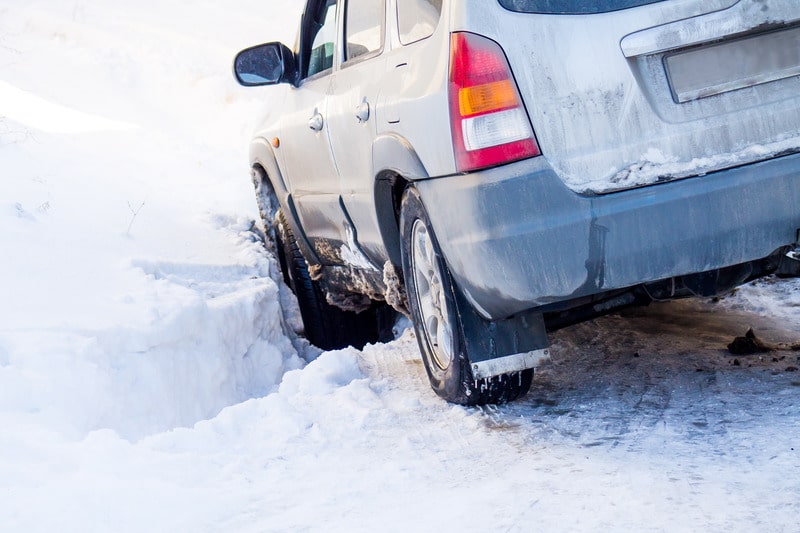
Although many United States residents live in an area with the potential for snow and ice, more than half a million accidents yearly occur in ice and snow-related weather conditions.
Ice and snow-related collisions account for an average of 138,735 injuries and 1,705 fatalities annually. Many drivers stick to their typical behaviors in snowy and icy conditions, causing them to lose control of their vehicle and strike an object, a person, or another vehicle.
While some drivers ignore safety precautions for snow and ice, others lack information about safe driving in such conditions.
Our team of car accident lawyers at River Run Law prepared a guide outlining ways to avoid a car accident in snow. If you have other questions about winter driving, contact our office today.
1. Drive Slowly
Snow and ice on roadways can prevent a vehicle’s tires from gaining traction with the road. Your tires can spin if you try to accelerate too quickly or make you slide forward if you slam on your brakes suddenly. Thus, it takes longer to get going and to slow down on snow or ice-covered roads.
You need to give yourself extra time to get to your location so you can drive as slowly as necessary. Slower driving also gives you more time to react to unexpected situations on the road and avoid a potential collision.
Even if you see other vehicles driving over the speed limit, remember that driving at lower speeds decreases the risk of causing a car accident.
2. Turn Off Cruise Control
Cruise control functions do not work effectively in icy or snowy conditions. If your vehicle starts sliding on a patch of ice, cruise control may automatically make your vehicle accelerate.
Accelerating on ice creates a high risk of losing control of your vehicle and causing a car accident. Cruise control does not monitor the conditions of the roadway, so it is best to keep the function turned off during poor weather conditions.
3. Check Road Conditions Before Leaving
An essential aspect of driving in bad weather is knowing what to expect. You should always check the weather forecast for your route and ultimate destination. The last thing you want to do is unexpectedly encounter a severe snowstorm with an empty gas tank.
In some cases, snow and ice force authorities to close roads or suggest alternative routes to minimize the risk of an accident. You should check whether any roads along your route are closed before you leave so you do not end up stuck at a roadblock.
4. Leave Extra Space Between Yourself and Other Vehicles
As stated above, it takes longer to slow down when there is snow or ice on the road.
It can take a vehicle as much as ten times as long to stop on ice than in normal weather conditions. To prevent your vehicle from sliding into the car in front of you, you should leave extra space between yourself and other vehicles when the roads are icy.
5. Check Your Headlights and Tail Lights
In many cases, snow limits a driver’s ability to see beyond the area right outside of their vehicle. Your headlights and tail lights can help other drivers see your vehicle on the road and prevent them from inadvertently running into you. A snowstorm is a bad time to discover that your headlights are inoperable.
6. Check the Quality of Your Tires
Good tires can mean the difference between driving in snow and simply sliding from one place to another. Bald tires are unlikely to get any traction on an icy road.
Many drivers install snow tires in regions with lots of ice and snow. Snow tires are made specifically to provide a better grip and maintain traction in ice, snow, and slushy conditions.
Even if you do not need snow tires, you should ensure that your tires have good tread and minimal wear and tear. You should also check the air pressure in your tires to make sure you do not have a flat.
7. Do Not Slam on Your Brakes
When a vehicle starts sliding on ice, the driver’s first instinct is often to smash their foot onto the brake pedal, hoping it will make the car come to a complete stop.
Despite your first instinct, slamming on your brakes is not a good idea in icy conditions. Instead, turn towards the direction you are sliding and take your foot off the accelerator. Once you regain control of your vehicle, you can brake slowly to come to a stop.
8. Use Your Turn Signals
Using turn signals is especially important when there is limited visibility on the roadway. You want to ensure other drivers know of your intentions during icy or snowy conditions. Activating your turn signal gives other drivers around you a chance to change lanes or slow down without making abrupt movements.
9. Keep Your Eyes on the Road
You should never drive while distracted, but focusing is especially important in poor road conditions. You should even avoid typically acceptable distractions like:
- Talking to passengers,
- Adjusting the radio station,
- Using Bluetooth to talk on the phone, or
- Singing along to the radio.
Deadly collisions occur in the blink of an eye, especially in icy and snowy conditions. Keeping your eyes on the road and your mind alert can mean the difference between a fatal injury and avoiding the collision altogether.
Do You Have Questions After a Car Accident in Snow? Contact a Richmond Car Accident Lawyer Today
Driving in icy or snowy conditions is often a stressful experience that can easily result in an accident. If you or a loved one suffered injuries in a car accident in ice or snow, contact one of our Richmond car accident lawyers immediately.
A car accident attorney at River Run Law in Richmond can investigate the circumstances of the accident and determine who is liable for your losses. We offer a free consultation to answer any of your questions.
Where You Can Find Our Richmond, VA Office Location

